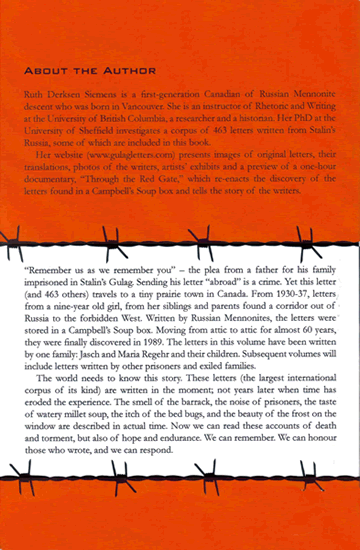 Excerpts from the Book
Excerpts from the BookPreface
It is August 1989, and Frank Bargen is cleaning out the attic of his Manitoba home. He has been storing some of his parents' belongings since they died twelve years earlier. Among the possessions is an old Campbell's Soup box. In casual conversation with his younger brother Peter Bargen and his wife Anne who are visiting, Frank refers to "a box of old letters" in the attic that are "just cluttering up the place." Peter finds the box, opens it up, and discovers hundreds of faded letters, some little more than scraps of paper. They are written in German gothic script and dated as early as 1930. To Peter's surprise, his mother had kept all of these letters from Russia until she died.
The correspondence is from aunts and uncles, grandparents and cousins, neighbours and friends, who by choice or fateful chance remained behind in the former Soviet Union. Their letters describe the inhumane conditions under which millions lived and died: from the mother dividing meagre portions of black bread among her starving children to the father prepared to freeze to death in order to provide for his children. Although the writers' words reveal human flaws and frailties, they also bring to light an elemental faith that united the Mennonite people for over 400 years.
It was only when the cardboard box emerged from the attic in 1989 that Peter began to comprehend the suffering of his people. For three years, he and Anne organized and translated 463 of the "pre-war" letters (1930-38). Peter learned of the events that took place in the hours immediately following his family's flight in 1929, and the unthinkable horrors experienced by those left behind in Soviet Russia. Peter and Anne wanted their children, grandchildren, and extended family to know their own story, so they printed one hundred copies of the 463-letter collection in 1991.
Significantly, research has confirmed that the letters from Stalin's Gulag comprise the largest international corpus of its kind to date. Also noteworthy is that these letters were written "in the moment." Unlike many published memoirs written years later, after memory and the passage of time have possibly eroded the experience, (e.g. Alexsandr Solzhenitsyn, Eugenia Ginsburg, Kseniia Medvededskaia) these letters capture the experiences of prisoners and villagers in actual time.
Clandestinely carried out of the country, the letters offer a rare glimpse into the bleakest chapter in the Soviet Union's history. They open a previously obscured window into both the day-to-day existence in Stalin's prison camps and the suffering of oppressed people in their home villages. Yet the letters also evoke the human spirit's most enduring quality: hope.
Translation of the Letters
Translating the letters presented numerous challenges for Peter and Anne Bargen. In their 1991 published collection, they note the following:
- Many letters are unsigned and undated. We have done our best to estimate by whom and at what time they were written.
- Many words, phrases and sentences are illegible because of faint writing, faulty spelling, abbreviations, smudging and unknown Russian expressions. We have tried to express the substance of the communication accurately.
- Many unknown or illegible "place names" in either German or Russian language are used by the correspondents and are written as they appear to the translator; they may be grossly misspelled (i).
The Bargens explain that they tried to reflect the essence of the letters as precisely as possible, and did not "sanitize" the story. It is also my intention to present the letters accurately and to preserve the integrity of the writers. In publishing this book, I have insisted on keeping the letters intact. The writers do not need to be censored once again. However, to guide the reader, I provide contextual information, clarify family relations, and define some Russian terms and ethnic expressions. Most spellings of geographical locations follow the Germanic-Mennonite conventions used by the letter writers. In some cases, Library of Congress spellings (in non-Cyrillic alphabet) are used to represent Russian words used by the writers. Ellipses generally indicate either words that are missing in the original letter or handwriting that is impossible to decipher.
Overview
This volume begins with an introduction to the Mennonite people. It describes their journey from parts of Europe in the sixteenth century to Russia in the eighteenth century. It also narrates the odyssey of Mennonites from a golden age of relative peace and prosperity to the dark prisons of the Gulag in the twentieth century.
Chapter One begins includes the early letters of Jasch and Maria Regehr and their six children, recounting their arrest in 1930, imprisonment, and exile. Chapter Two presents the letters written from various prison camps to which the Regehr family was transported (1932-33). Chapter Three contains letters written in the following year (1933-34) which reflect a loss of hope after several deaths in the family. The number of letters drops dramatically after 1934; those in Chapter Four reveal the increasing vulnerability of the remaining family members. The letters stop in 1937. Decades of silence follow.
Then, after more than fifty years, two surviving sisters, Lena and Mariechen, "fill in the blanks." Their letters are included in Chapter Five. Renewal is evident in this chapter, which recounts a meeting with Lena in 2005 in Cologne, Germany. The only remaining survivor of the Regehr family – the little girl who wrote a letter from her cramped space in a prison barrack, the woman who embodies the pain of an oppressed people – now radiates with hope for her daughter and two granddaughters. The Epilogue invites readers to respond to Jasch and Maria's plea: "Remember us."
Note: For purchases outside of Canada: Please contact us directly for arrangements.
Book: |
To purchase via cheque, please contact us

Additional Information
Media Reviews and Responses
About the Book
Table of Contents




